Introduction
Throughout Florida, freshwater ornamental fish are predominantly farmed in earthen ponds. Once fish reach marketable size and are ready for sale, they must be harvested. Careful preparation and handling will minimize losses due to stress and physical damage during harvesting (see UF/IFAS Circular 919 Stress-Its Role in Fish Disease, https://edis.ifas.ufl.edu/fa005). Overall, collecting and moving fish as quickly and carefully as possible reduces potential risks.
Traps and seine nets are common harvesting tools that have been in use since the 1930s. A 1999 survey of ornamental aquaculture practices conducted by the University of Florida's Tropical Aquaculture Laboratory on ornamental aquaculture practices revealed that 59% of respondents used traps to harvest fish and 79% used seines.
Trapping or seining a given number of fish from a pond takes roughly the same amount of time on a per pond basis under normal conditions; however, the time required may vary according to the number of fish needed to fill an order (i.e., increased number of traps or seine pulls required for more fish). Also, seining usually requires at least 2 people, whereas trapping only requires one. An important factor in farm management is minimizing labor cost.
Commonly used traps include the wire minnow trap (Figure 1) and the acrylic trap (Figure 2), also called a live-bearer trap. While traps are useful for harvesting, they require baiting which can be time consuming and messy. Traps may require more storage space than a seine depending on the number of traps required. Seine nets can be easily stored and are relatively inexpensive. However, fish that are trapped usually have less physical damage than those that are seined.
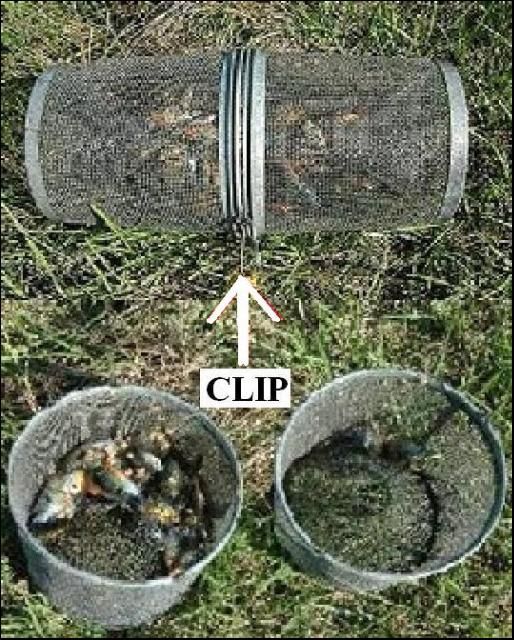
Credit: Tina Crosby (2004)

Credit: Tina Crosby (2004)
Another tool used to harvest fish is the cast net. Cast nets come in various sizes, and they can be effective and quick. However, cast nets abrade the skin of the fish, causing scale loss and other physical damage. During cast netting, bait is thrown into the water, concentrating fish into one area. The cast net is thrown over the fish, and the catch is hauled to shore where the fish are placed into a waiting transport container.
There are advantages and disadvantages of both trapping and seining as a means of harvesting fish. The farmer must carefully decide which method causes the least physical damage and stress to the fish while yielding the necessary numbers within a reasonable amount of time. Before starting to harvest fish from ponds, there must be a plan of action so that the harvesting event is conducted in a quick and efficient manner.
Harvesting Methods
Trapping
Live-bearer (e.g., mollies, platies, and swordtails) ponds are typically managed as continuous production ponds. That means that these ponds generally operate for six months to one year, but they can be run for as long as three years or more without draining the pond. This extended production time results in a fish population ranging from newly born fry to adults. Because of the resulting disparity in fish sizes, ponds managed in this way are suited to harvesting primarily by trapping. Trapping allows for size selection as part of the harvesting process.
Wire minnow traps (Figure 1) are constructed of two tapered cylindrical halves with inverted cones that have a small central opening for fish to enter the trap (e.g., Figure 1, each half is 8¾-inch diameter tapering to a 7¼-inch diameter, with an overall length of 16 inches when assembled). They are made of 1/8-inch mesh with an open design that allows for water flow through the trap.
A clip is used to clamp both trap halves together (Figure 1) and it also serves as the point of connection for an anchor line to be tied to a stake on the bank, securing the trap to the shore for easy retrieval. The bottom trap in Figure 1 shows how the trap comes apart to remove fish. Traps are baited with floating fish pellets or a homemade grain-based paste. These pastes vary in composition, but they are composed primarily of oats or flour combined with molasses and finely ground or powdered fish food. Once baited, traps are deployed or "soaked" in the pond. Traps are placed at a depth of 1–3 feet for 15 minutes to 6 hours (average time is 1.5 hours).
During harvest, the trap is hauled in by the anchor line, and the clip is removed. The fish can either be size graded pondside in the water with a floating box grader or carefully transferred from the trap into a transport container. The farmer can then choose to cull or visually grade the fish at the pond or transport them to a holding facility (see UF/IFAS Fact Sheet FA-119 On Farm Transport of Ornamental Fish, https://edis.ifas.ufl.edu/FA119). Grading is the mechanical separation or visual inspection of fish to select for desired characteristics such as size or color (see UF/IFAS Fact Sheet FA-118 Grading Ornamental Fish, https://edis.ifas.ufl.edu/FA118). Culling is the removal of unwanted fish that do not display desired characteristics.
Commonly used acrylic traps (Figure 2 and Figure 3) are trapezoidal-shaped columns (e.g., 15¼-inch long x 6-inch tall x 5¼-inch wide at top and 7¼-inch wide at bottom). These clear traps have an inverted cone opening on one end for fish to enter the trap, a mesh covering over the opposite end for removing fish, and a metal handle on top, to which a line can be attached (Figure 2). These traps are baited (with prepared or live feeds such as small feeder fish to catch cichlids) through the inverted cone opening and hauled in by the anchor line. Grading and culling proceed in the same manner as with wire traps.
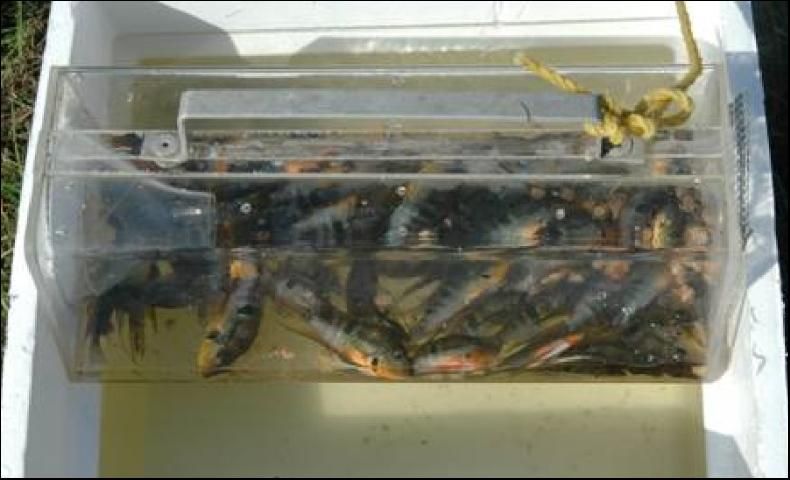
Credit: Tina Crosby (2004)
Seining
Seine nets (Figure 4) are used primarily to harvest egg-layers from ponds. These ponds are typically stocked with fish of the same age and subsequently harvested (roughly 3–4 months later, depending on species) in one day or within several days to obtain fish of approximately the same size. Ponds can be pumped down or drained to concentrate the fish into a smaller volume of water prior to harvest.
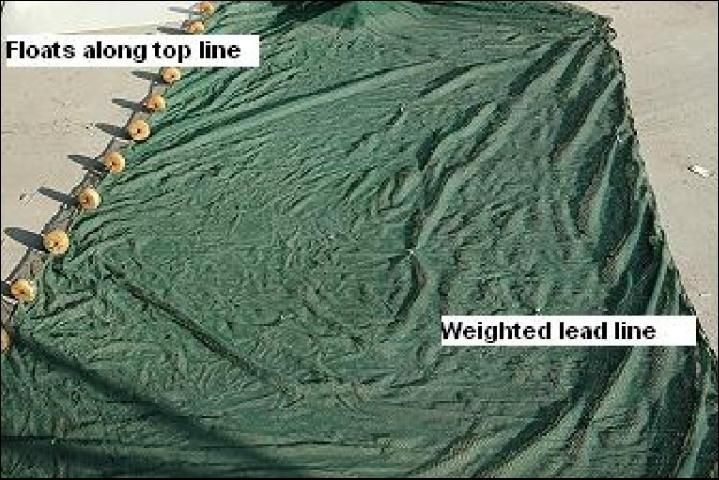
Credit: Tina Crosby (2004)
The length of the seine net should be 1½ times wider than the widest section of the pond, and 1½ times taller than the maximum depth of the water. A seine this size will create a basket or purse that will corral the fish. The mesh size should be small enough to catch the fish without gilling them (i.e., catching fish by their gill coverings [opercula] when they try to swim through the net), yet large enough to allow pond mud to pass through easily. Size and depth of the pond also determine the seine needed. Seine nets used to harvest tropical fish are typically 20-feet to 50-feet long x 6-feet to 8-feet deep, with a mesh size ranging from less than 1/8 to 1/2 inch.
Seine nets are typically made of nylon or polyester with a knotless weave to minimize injury to the fish. These nets can be coated with "green dip," a special rubberized paint which increases the life of the seine. Polystyrene floats are secured every 8 to 12 inches along the top or float line, and lead weights are secured every 8 to 10 inches along the bottom or lead line. An ornamental fish seine has twice as many floats and weights as a standard food fish seine because small ornamental fish can escape both over and under a normal seine net. When ordering an ornamental fish seine, double floats and weights should be requested.
Seines are usually pulled by at least two people, who walk along either side of the pond, tending to their respective float and lead lines (Figure 5). The seine can be pulled from one end of the pond to the other; this method is known as a "full pull." To minimize the amount of stress placed on the fish, the number of fish caught can be reduced by performing a half pull, seining only half a pond from the middle to one end, or even a quarter pull, seining only one quarter of the pond to one end.
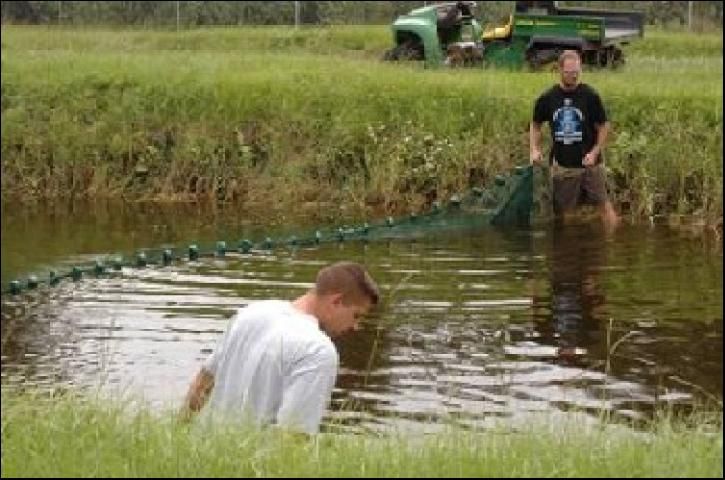
Credit: Tina Crosby (2004)
Some farmers use a pole, known as a braille, attached to each end of the seine at the float line and the lead line. The braille helps manipulate the seine while continuously keeping the netting spread open. Other farmers prefer to hold the float line in one hand while dragging the lead line with their foot. It should be noted that regardless of the chosen seining technique, the seine should be advanced slowly to ensure that the float line does not go under the surface of the water, and more importantly, that the lead line does not rise off the bottom.
At the far end of the pond, the ends of the seine are pulled up directly onto the shore, and the remainder of the net is brought in by hand to form a basket for concentrating the catch (Figure 6). The collected fish can then be added directly to the transport container at one time, commonly referred to as a "dump and run." A more gentle method involves carefully dip-netting the fish out of the seine into a transport container (Figure 7). It is important not to overload the dip net with fish. Crowding of fish may cause fish injury and damage to their appearance.

Credit: Tina Crosby (2004)
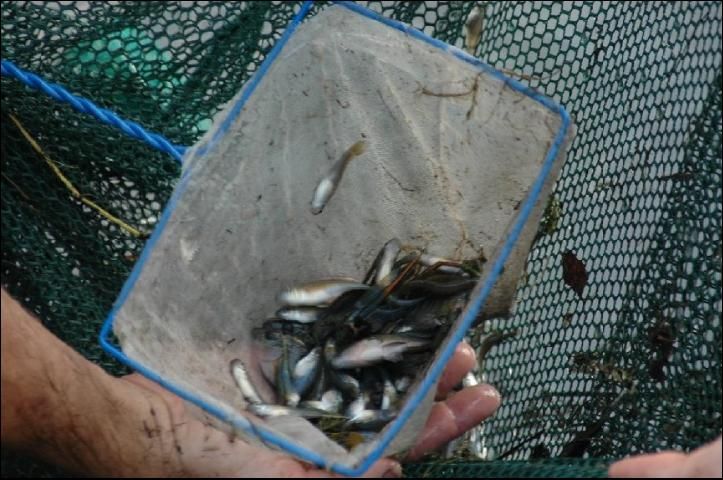
Credit: Tina Crosby (2004)
Advantages and Disadvantages
Trapping
Acrylic traps are primarily made of solid pieces of transparent acrylic and, by design, they cause less abrasion and physical damage to the fish than wire traps. However, unlike wire traps, water can only flow through the two ends of an acrylic trap which can lead to water quality problems within the trap far sooner than is typical with wire traps. Therefore, acrylic traps must be closely monitored to avoid high ammonia levels, low dissolved oxygen levels, or other critical changes in water quality (see UF/IFAS Fact Sheet FA-16 Ammonia, https://edis.ifas.ufl.edu/FA031 and UF/IFAS Fact Sheet FA-27 Dissolved Oxygen for Fish Production, https://edis.ifas.ufl.edu/FA002). While acrylic traps help reduce abrasion, they can cost four or five times more than wire traps, and they require more storage space.
High densities of fish in wire traps can degrade water quality within the trap and fish may abrade themselves against the wire. Therefore, wire traps must also be monitored for fish numbers. In addition, the mesh of a wire trap may gill smaller fish.
Fish species must be taken into consideration when deciding placement of traps and whether trapping or seining is required. For example, gouramis breathe atmospheric oxygen using a specialized structure called a labyrinth organ. If a trap is completely submerged, gouramis will not be able to aquire enough oxygen from the water via their gills and will drown. If a trap is used, some part of it must be placed and secured above the water line to allow the fish to respire at the surface.
Under optimal conditions, trapping can yield a large number of fish with minimal effort, and traps can be baited, deployed, and harvested by one person. However, when fish are not being trapped as well as needed or expected, additional traps may need to be deployed, additional ponds may need to be trapped, or the fish may need to be seined from the pond to harvest the desired number of fish.
Seining
Using seine nets can be very efficient, but it may be necessary to make several full pulls through the pond, even with lowered pond water levels, to complete the harvest. With each successive pull of the seine, the lead line disturbs the sediment and increases turbidity. Excessive suspended sediments reduce the efficiency of a fish's breathing by clogging its gill filaments. This problem, compounded by decreasing dissolved oxygen levels, can result in acute mortalities. Another important consideration during seining is the fact that hydrogen sulfide (H2S) gas may be released into the water by the disturbance of bottom sediment. Hydrogen sulfide is a by-product of decaying organic matter in the mud of a pond. This gas is lethal to fish in high concentrations. Fortunately, in most ornamental fish ponds, the production turnover time is usually more frequent (months) than in many food fish ponds (years), so an ornamental pond is drained and cleaned more often, decreasing the risk of releasing hydrogen sulfide gas into the water. The best way to combat these problems is to quickly and efficiently harvest the fish.
Even though seining allows harvest of large numbers of fish in a short amount of time, seines can be harsh on fish. Care should be taken to minimize scale loss, skin abrasions, fin and eye damage, and mortality.
Summary
It is the producer's responsibility to choose the best harvesting technique for the fish species being raised and for the quantities required. Regardless of the method chosen, care should always be used to reduce or eliminate the amount of stress placed on the fish. The farmer should understand the differences between trapping and seining including specific considerations for each technique.
When using either wire or acrylic traps, the number and type of traps used, the method of baiting traps, and the placement of traps (e.g., depth) are all important factors. A more critical consideration is the length of time the traps are deployed, especially when the acrylic traps are used. Careful monitoring of the traps will help avoid overcrowding that may result in stress to the fish and acute mortalities.
When using a seine, the farmer should be careful to choose the appropriate length of pull (one quarter, one half, or full). This consideration will help control the number of fish corralled in the net, minimize physical damage to the fish, and ensure quality of the fish. The dissolved oxygen concentration in the remaining pond water should also be monitored, especially when multiple pulls are required to complete the harvest.
Additional factors, such as the number of fish needed to fill an order, the number of workers available, the amount of time available for harvesting, and the weather, should be taken into account. When careful consideration and preparation are taken before and during harvest, a high-quality product will be available for market.
Recommended Reading
UF/IFAS Circular 120 Fish Health Management Considerations in Recirculating Aquaculture Systems - Part 1: Introduction and General Principles. https://edis.ifas.ufl.edu/FA099
UF/IFAS Circular 121 Fish Health Management Considerations in Recirculating Aquaculture Systems - Part 2: Pathogens. https://edis.ifas.ufl.edu/FA100
UF/IFAS Circular 122 Fish Health Management Considerations in Recirculating Aquaculture Systems - Part 3: General Recommendations and Problem-Solving Approaches. https://edis.ifas.ufl.edu/FA101
UF/IFAS Circular 919 Stress - Its Role in Fish Disease. https://edis.ifas.ufl.edu/FA005
UF/IFAS Fact Sheet FA-7 Fish Fingerlings: Purchasing, Transporting, and Stocking. https://edis.ifas.ufl.edu/FA013
UF/IFAS Fact Sheet FA-16 Ammonia. https://edis.ifas.ufl.edu/FA031
UF/IFAS Fact Sheet FA-27 Dissolved Oxygen for Fish Production. https://edis.ifas.ufl.edu/FA002
UF/IFAS Fact Sheet FA-118 Grading Ornamental Fish. https://edis.ifas.ufl.edu/FA118
UF/IFAS Fact Sheet FA-119 On Farm Transport of Ornamental Fish. https://edis.ifas.ufl.edu/FA119
UF/IFAS Fact Sheet FA-120 Preparation of Ornamental Fish for Shipping. https://edis.ifas.ufl.edu/FA120
SRAC Publication No. 462 Nitrite in Fish Ponds. https://agrilife.org/fisheries2/files/2013/09/SRAC-Publication-No.-462-Nitrite-in-Fish-Ponds.pdf
SRAC Publication No. 463 Ammonia in Fish Ponds. https://agrilife.org/fisheries2/files/2013/09/SRAC-Publication-No.-463-Ammonia-in-Fish-Ponds.pdf
SRAC Publication No. 468 Carbon Dioxide in Fish Ponds. https://agrilife.org/fisheries2/files/2013/09/SRAC-Publication-No.-468-Carbon-Dioxide-in-Fish-Ponds.pdf
SRAC Publication No. 474 The Role of Stress in Fish Disease. https://www.ncrac.org/files/biblio/SRAC0474.pdf
SRAC Publication No. 4601 Measuring Dissolved Oxygen Concentration in Aquaculture. https://agrilife.org/fisheries2/files/2013/09/SRAC-Publication-No.-4601-Measuring-Dissolved-Oxygen-Concentration-in-Aquaculture.pdf